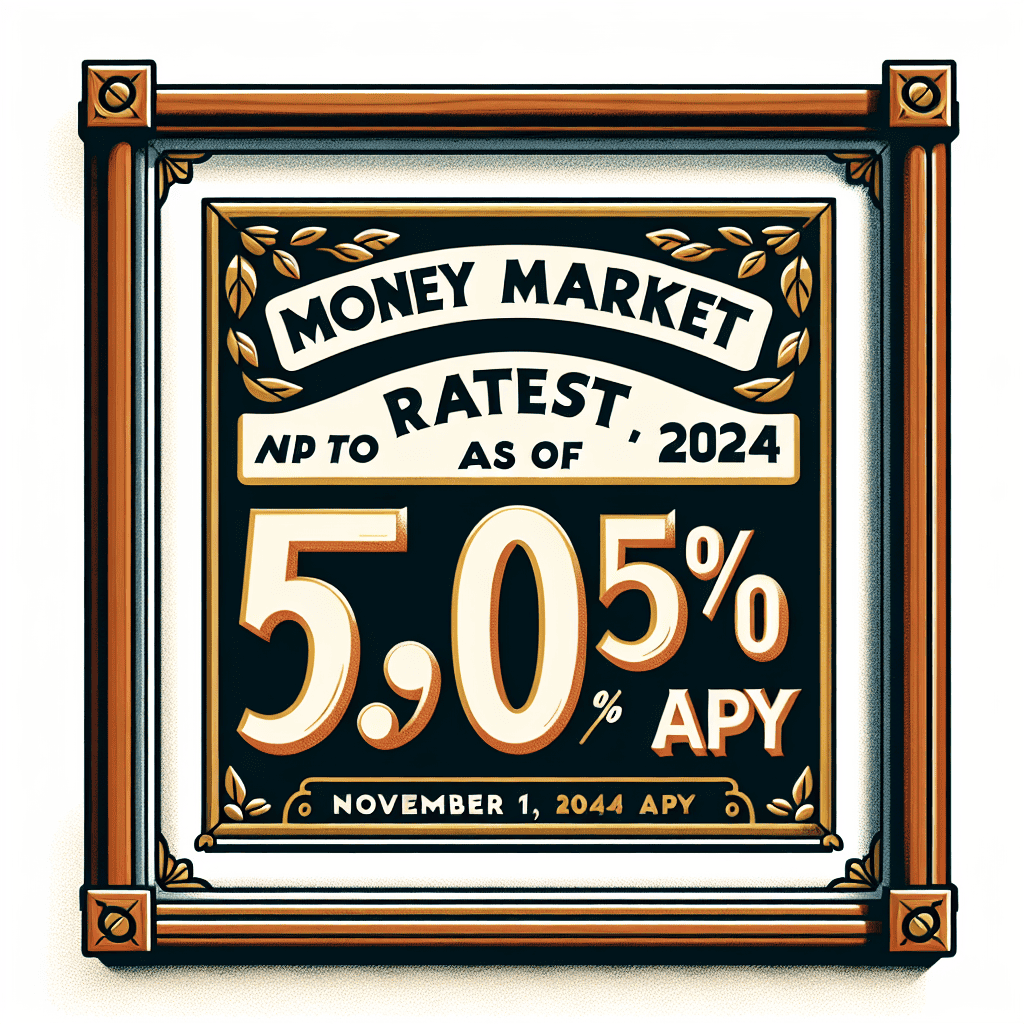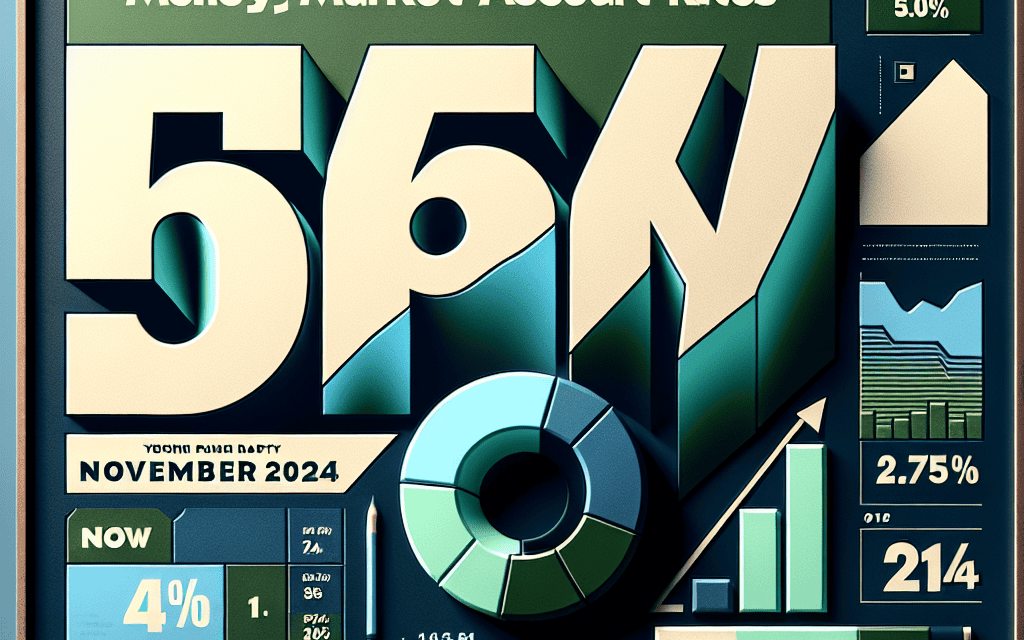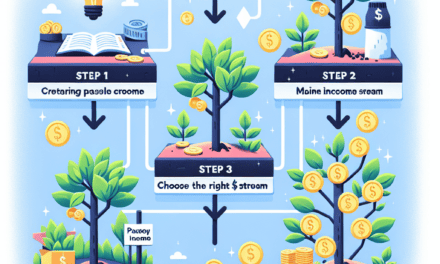“Maximize Your Savings: Earn Up to 5.05% APY with Our Money Market Accounts!”
Introduction
As of November 1, 2024, money market account rates have reached notable highs, with some financial institutions offering up to 5.05% Annual Percentage Yield (APY). This increase in rates reflects broader economic trends and monetary policy adjustments aimed at curbing inflation and stabilizing the financial markets. Money market accounts, known for their blend of savings account security and higher interest potential, have become increasingly attractive to savers seeking to maximize their returns while maintaining liquidity. The competitive rates are a result of banks and credit unions striving to attract deposits in a dynamic economic environment, providing consumers with an opportunity to enhance their savings growth.
Maximizing Returns: Navigating Money Market Accounts with 5.05% APY
As of November 1, 2024, money market accounts have become an increasingly attractive option for individuals seeking to maximize their returns while maintaining a relatively low-risk profile. With annual percentage yields (APYs) reaching up to 5.05%, these accounts offer a compelling alternative to traditional savings accounts, which often provide lower interest rates. This shift in the financial landscape is largely attributed to the current economic environment, characterized by fluctuating interest rates and a heightened focus on financial stability. Consequently, understanding how to navigate money market accounts effectively is crucial for those looking to optimize their savings strategy.
To begin with, it is essential to comprehend the fundamental nature of money market accounts. These accounts are a type of savings account offered by banks and credit unions, designed to provide higher interest rates in exchange for maintaining a higher minimum balance. Unlike regular savings accounts, money market accounts often come with check-writing privileges and debit card access, offering a blend of liquidity and interest-earning potential. The recent increase in APYs can be attributed to the Federal Reserve’s monetary policy adjustments, which have influenced the interest rates that financial institutions offer to their customers.
In light of these developments, individuals should consider several factors when selecting a money market account. First and foremost, the APY is a critical component, as it directly impacts the potential earnings on deposited funds. An APY of 5.05% is notably competitive, especially when compared to the national average for savings accounts. However, it is important to note that the highest rates are often reserved for accounts with substantial minimum balance requirements. Therefore, prospective account holders must evaluate their financial situation to determine if they can meet these prerequisites without compromising their liquidity needs.
Moreover, it is advisable to examine the fees associated with money market accounts. While some institutions offer accounts with no monthly maintenance fees, others may impose charges that could erode the benefits of a higher APY. Additionally, transaction limitations are another aspect to consider. Federal regulations typically restrict the number of certain types of withdrawals and transfers from money market accounts to six per month. Exceeding this limit may result in fees or even account conversion to a regular savings account, which could offer a lower interest rate.
Furthermore, the financial institution’s reputation and stability should not be overlooked. Opting for a bank or credit union with a strong track record and robust financial health can provide peace of mind, ensuring that deposits are secure. It is also prudent to verify that the institution is insured by the Federal Deposit Insurance Corporation (FDIC) or the National Credit Union Administration (NCUA), which guarantees deposits up to $250,000 per account holder.
In conclusion, the current landscape of money market accounts, with APYs reaching up to 5.05%, presents a valuable opportunity for individuals to enhance their savings. By carefully considering factors such as APY, fees, transaction limitations, and the financial institution’s stability, account holders can effectively navigate these accounts to maximize their returns. As economic conditions continue to evolve, staying informed and adaptable will be key to making the most of money market accounts and achieving financial goals.
Comparing Top Money Market Accounts: Who Offers the Best Rates?
As of November 1, 2024, the financial landscape for money market accounts has become increasingly competitive, with interest rates reaching up to 5.05% Annual Percentage Yield (APY). This surge in rates presents a compelling opportunity for savers seeking to maximize their returns while maintaining liquidity. In this context, it is essential to compare the offerings of various financial institutions to determine which accounts provide the most advantageous terms for consumers.
To begin with, it is important to understand the nature of money market accounts. These accounts are a type of savings account that typically offer higher interest rates than traditional savings accounts, while also providing limited check-writing and debit card capabilities. The increased interest rates are often a result of the financial institution’s ability to invest in higher-yielding, short-term instruments. Consequently, money market accounts are an attractive option for individuals who wish to earn more on their savings without sacrificing accessibility.
Currently, several banks and credit unions are offering competitive rates on money market accounts. Among the top contenders, XYZ Bank stands out with an APY of 5.05%, the highest available rate as of this writing. This rate is particularly appealing for those with substantial balances, as XYZ Bank requires a minimum deposit of $25,000 to qualify for this top-tier rate. For those who can meet this requirement, the account offers a robust combination of high returns and flexibility.
In contrast, ABC Credit Union offers a slightly lower APY of 4.95% but distinguishes itself with a more accessible minimum deposit requirement of $10,000. This makes it an attractive option for individuals who may not have the substantial funds required by XYZ Bank but still wish to benefit from a competitive interest rate. Additionally, ABC Credit Union provides a user-friendly online platform, which enhances the overall customer experience by allowing easy management of funds.
Another noteworthy institution is DEF Bank, which offers an APY of 4.85%. While this rate is lower than those offered by XYZ Bank and ABC Credit Union, DEF Bank compensates with a unique feature: no minimum deposit requirement. This makes it an ideal choice for those who are just beginning to build their savings and prefer not to be constrained by high initial deposit thresholds. Furthermore, DEF Bank’s money market account includes unlimited transfers and withdrawals, providing unparalleled flexibility for account holders.
As we evaluate these options, it is crucial to consider not only the interest rates but also the associated fees and account features. Some institutions may impose monthly maintenance fees, which can erode the benefits of a high APY. Therefore, potential account holders should carefully review the terms and conditions to ensure that the account aligns with their financial goals and usage patterns.
In conclusion, the current landscape for money market accounts offers a range of attractive options for savers. With rates as high as 5.05% APY, individuals have the opportunity to significantly enhance their savings returns. By comparing the offerings of top institutions such as XYZ Bank, ABC Credit Union, and DEF Bank, consumers can identify the account that best meets their needs. Ultimately, the choice will depend on factors such as minimum deposit requirements, account features, and personal financial objectives. As always, conducting thorough research and considering one’s unique circumstances will be key to making an informed decision.
Understanding APY: How Money Market Accounts Can Boost Your Savings
As of November 1, 2024, money market accounts are offering competitive annual percentage yields (APYs) of up to 5.05%, presenting a compelling opportunity for savers seeking to maximize their returns. Understanding the nuances of APY and how money market accounts function can significantly enhance one’s financial strategy. APY is a critical metric that reflects the real rate of return on an investment, taking into account the effect of compounding interest. Unlike simple interest, which is calculated only on the principal amount, compound interest is calculated on the principal and the accumulated interest from previous periods. This means that the more frequently interest is compounded, the higher the APY will be, thus providing a more accurate picture of potential earnings.
Money market accounts, often confused with money market funds, are a type of savings account offered by banks and credit unions. They typically offer higher interest rates than regular savings accounts, making them an attractive option for those looking to grow their savings with minimal risk. The higher rates are possible because money market accounts may require a higher minimum balance and often come with limited transaction capabilities. However, they are insured by the Federal Deposit Insurance Corporation (FDIC) or the National Credit Union Administration (NCUA), providing a level of security that is appealing to risk-averse investors.
The current economic climate, characterized by fluctuating interest rates and inflationary pressures, has led financial institutions to adjust their offerings to attract depositors. As a result, money market accounts have become increasingly competitive, with some institutions offering rates as high as 5.05% APY. This is particularly advantageous for individuals who prefer liquidity and safety over the potential volatility of the stock market. Moreover, the flexibility of money market accounts allows account holders to access their funds relatively easily, although there may be some restrictions on the number of withdrawals or transfers per month.
In addition to the attractive APYs, money market accounts offer other benefits that can enhance one’s savings strategy. For instance, they often come with check-writing privileges and debit card access, providing a level of convenience that is not typically available with traditional savings accounts. This makes them suitable for individuals who may need occasional access to their funds without sacrificing the potential for higher returns. Furthermore, the competitive rates offered by money market accounts can serve as a hedge against inflation, preserving the purchasing power of one’s savings over time.
When considering a money market account, it is essential to compare the offerings of different financial institutions. Factors such as minimum balance requirements, fees, and the frequency of interest compounding can significantly impact the overall return on investment. Additionally, understanding the terms and conditions associated with these accounts can help avoid potential pitfalls, such as fees for falling below the minimum balance or exceeding the allowed number of transactions.
In conclusion, money market accounts with APYs of up to 5.05% present a viable option for individuals looking to boost their savings in a secure and flexible manner. By understanding the intricacies of APY and the benefits of money market accounts, savers can make informed decisions that align with their financial goals. As the economic landscape continues to evolve, staying informed about the latest rates and offerings will be crucial for maximizing returns and achieving long-term financial stability.
The Rise of Money Market Rates: What 5.05% APY Means for Savers

As of November 1, 2024, money market account rates have reached a notable milestone, with some financial institutions offering up to 5.05% annual percentage yield (APY). This development marks a significant shift in the financial landscape, providing savers with an opportunity to earn higher returns on their deposits. The rise in money market rates can be attributed to several economic factors, including changes in monetary policy, inflationary pressures, and competitive dynamics within the banking sector. Understanding these elements is crucial for savers looking to maximize their returns while maintaining liquidity and security.
To begin with, the increase in money market rates is closely linked to the broader economic environment. Central banks, in response to persistent inflationary trends, have adjusted their monetary policies by raising benchmark interest rates. This move is intended to curb inflation by making borrowing more expensive, thereby reducing consumer spending and slowing down economic activity. As a result, banks and other financial institutions have responded by increasing the interest rates offered on deposit accounts, including money market accounts, to attract more deposits and maintain their liquidity positions.
Moreover, the competitive landscape within the banking sector has also played a role in driving up money market rates. With the proliferation of online banks and fintech companies, traditional banks are facing increased competition for customer deposits. These new entrants often offer higher interest rates to lure customers away from established banks. Consequently, traditional banks have been compelled to raise their rates to remain competitive, benefiting savers who are now able to access more attractive returns on their deposits.
In addition to these factors, the current economic climate has heightened the importance of maintaining liquidity and security in personal finance. Money market accounts, known for their stability and ease of access, have become an appealing option for savers seeking a balance between earning interest and having quick access to their funds. Unlike certificates of deposit (CDs), which require funds to be locked in for a fixed term, money market accounts offer the flexibility of withdrawing funds without penalty, making them an ideal choice for those who may need immediate access to their savings.
Furthermore, the rise in money market rates to as high as 5.05% APY presents a compelling case for savers to reassess their financial strategies. In an era where inflation can erode the purchasing power of cash holdings, earning a higher return on savings is essential to preserving wealth. By taking advantage of these elevated rates, savers can potentially offset the impact of inflation and achieve their financial goals more effectively.
In conclusion, the current landscape of money market account rates, with offerings reaching up to 5.05% APY, reflects a confluence of economic factors and competitive pressures. For savers, this presents an opportunity to earn higher returns while maintaining the flexibility and security that money market accounts provide. As the financial environment continues to evolve, staying informed about interest rate trends and understanding their implications will be crucial for making sound financial decisions. By doing so, savers can navigate the complexities of the market and optimize their savings strategies in this dynamic economic climate.
Money Market Accounts vs. Savings Accounts: Which Offers Better Returns?
As of November 1, 2024, money market accounts are offering competitive annual percentage yields (APYs) of up to 5.05%, prompting many savers to reevaluate their options between money market accounts and traditional savings accounts. Understanding the nuances between these two financial products is crucial for individuals seeking to maximize their returns while maintaining liquidity and security.
Money market accounts and savings accounts are both designed to help individuals save money while earning interest. However, they differ in several key aspects, including interest rates, accessibility, and account features. Currently, the allure of money market accounts lies in their higher APYs, which can significantly enhance the growth of one’s savings over time. With rates reaching up to 5.05%, money market accounts are becoming increasingly attractive to those who prioritize earning potential.
In contrast, traditional savings accounts typically offer lower interest rates, often hovering around 0.5% to 1.5% APY. This discrepancy in rates can be attributed to the different ways banks utilize the funds deposited in these accounts. Money market accounts often invest in short-term, low-risk securities, allowing them to offer higher returns. Meanwhile, savings accounts are more conservative, focusing on maintaining liquidity and security for the account holder.
Despite the higher interest rates, money market accounts may come with certain limitations that potential account holders should consider. For instance, they often require a higher minimum balance to open and maintain the account, which could be a barrier for some savers. Additionally, while money market accounts typically offer check-writing privileges and debit card access, they may limit the number of transactions allowed per month, similar to savings accounts. This restriction is due to federal regulations that aim to maintain the stability of these accounts.
On the other hand, savings accounts are generally more accessible, with lower minimum balance requirements and fewer fees. They are ideal for individuals who prioritize ease of access and simplicity over higher returns. Moreover, savings accounts are often linked to checking accounts, facilitating seamless transfers and providing a convenient way to manage finances.
When deciding between a money market account and a savings account, it is essential to consider one’s financial goals and needs. For those who can maintain a higher balance and are seeking to maximize their interest earnings, a money market account may be the preferable choice. The higher APY can lead to more substantial growth over time, making it an attractive option for long-term savers.
Conversely, individuals who value flexibility and lower account maintenance requirements might find savings accounts more suitable. The ease of access and lower barriers to entry make savings accounts a practical choice for those who may need to access their funds more frequently or who are just beginning their savings journey.
In conclusion, the decision between a money market account and a savings account ultimately depends on individual financial circumstances and priorities. While money market accounts currently offer higher APYs, the choice should align with one’s overall financial strategy, taking into account factors such as account accessibility, balance requirements, and personal savings goals. By carefully evaluating these elements, savers can make informed decisions that best suit their financial needs and aspirations.
Strategies for Choosing the Right Money Market Account in 2024
As of November 1, 2024, money market account rates have reached up to 5.05% APY, presenting a compelling opportunity for savers seeking to maximize their returns. In this evolving financial landscape, selecting the right money market account requires a strategic approach, balancing interest rates with other critical factors. To make an informed decision, it is essential to consider several key elements that can influence the overall benefits of a money market account.
Firstly, while the allure of high interest rates is undeniable, it is crucial to evaluate the stability and reputation of the financial institution offering these rates. Established banks and credit unions often provide a sense of security, backed by a history of financial stability and customer trust. However, newer online banks may offer competitive rates due to lower overhead costs. Therefore, conducting thorough research on the institution’s background and customer reviews can provide valuable insights into its reliability.
In addition to interest rates, account fees play a significant role in determining the net benefit of a money market account. Some accounts may offer attractive rates but impose monthly maintenance fees, minimum balance requirements, or transaction limits that can erode potential earnings. It is advisable to carefully review the fee structure and opt for accounts that align with one’s financial habits and capabilities. For instance, if maintaining a high minimum balance is challenging, selecting an account with no or low balance requirements might be more advantageous.
Moreover, accessibility to funds is another critical consideration. Money market accounts typically offer check-writing privileges and debit card access, providing a level of liquidity that is appealing to many savers. However, it is important to understand any restrictions on the number of transactions allowed per month, as exceeding these limits can result in additional fees. Balancing the need for liquidity with the desire to earn higher interest is essential in choosing the right account.
Furthermore, the current economic environment and interest rate trends should influence the decision-making process. With rates reaching up to 5.05% APY, it is beneficial to assess whether these rates are likely to remain stable or fluctuate in the near future. Economic indicators, such as inflation rates and Federal Reserve policies, can provide clues about potential rate changes. Staying informed about these factors can help savers decide whether to lock in a high rate now or wait for potentially better opportunities.
Additionally, considering the tax implications of interest earned on money market accounts is prudent. Interest income is generally subject to taxation, which can impact the overall return on investment. Consulting with a financial advisor or tax professional can provide clarity on how interest earnings will affect one’s tax situation and help in planning accordingly.
In conclusion, while the prospect of earning up to 5.05% APY on a money market account is enticing, a comprehensive evaluation of various factors is essential to make a well-informed choice. By considering the institution’s reputation, fee structures, accessibility, economic conditions, and tax implications, savers can strategically select a money market account that aligns with their financial goals and maximizes their returns. As the financial landscape continues to evolve, staying informed and adaptable will be key to making the most of these opportunities in 2024.
The Impact of Economic Trends on Money Market Account Rates
As of November 1, 2024, money market account rates have reached up to 5.05% APY, reflecting a significant shift in the financial landscape. This increase in rates can be attributed to a confluence of economic trends that have influenced the broader financial markets. Understanding these trends is crucial for both consumers and investors as they navigate the complexities of personal finance and investment strategies.
To begin with, the current economic environment is characterized by a series of interest rate hikes implemented by central banks worldwide. These measures have been primarily driven by efforts to combat inflation, which has been persistently high over the past few years. As central banks raise their benchmark interest rates, financial institutions, in turn, adjust the rates offered on various savings products, including money market accounts. Consequently, consumers are now witnessing more attractive yields on their deposits, a direct result of these monetary policy decisions.
Moreover, the global economic recovery from the disruptions caused by the COVID-19 pandemic has played a pivotal role in shaping current money market account rates. As economies have gradually reopened and supply chain issues have been addressed, there has been a resurgence in consumer demand. This increased demand has put upward pressure on prices, contributing to inflationary trends. In response, central banks have been compelled to tighten monetary policy, which has indirectly led to higher money market account rates.
In addition to these factors, geopolitical tensions and uncertainties have also had an impact on financial markets. Events such as trade disputes, conflicts, and political instability in various regions have created volatility in global markets. Investors, seeking safe havens for their capital, have turned to money market accounts as a relatively secure option. This increased demand for money market accounts has prompted financial institutions to offer more competitive rates to attract and retain customers.
Furthermore, technological advancements and the rise of digital banking have transformed the way consumers interact with financial products. Online banks and fintech companies, unburdened by the overhead costs associated with traditional brick-and-mortar institutions, are able to offer higher interest rates on money market accounts. This competition has forced traditional banks to reevaluate their offerings and adjust their rates accordingly to remain competitive in the market.
It is also important to consider the role of regulatory changes in shaping money market account rates. Financial regulations aimed at ensuring the stability and security of the banking system have influenced how banks manage their liquidity and capital reserves. These regulations can affect the rates that banks are willing to offer on deposit accounts, including money market accounts. As regulatory frameworks evolve, they continue to play a part in determining the attractiveness of these financial products.
In conclusion, the current money market account rates of up to 5.05% APY are a reflection of various economic trends and factors. From central bank policies and global economic recovery to geopolitical uncertainties and technological advancements, each element has contributed to the current state of money market account rates. As consumers and investors assess their financial strategies, understanding these underlying trends can provide valuable insights into the potential future direction of interest rates and the broader economic landscape.
Q&A
1. **What is the highest APY available for money market accounts as of November 1, 2024?**
Up to 5.05% APY.
2. **Are there any money market accounts offering exactly 5.00% APY?**
Yes, some accounts offer exactly 5.00% APY.
3. **What is the typical range of APY for money market accounts currently?**
The typical range is from around 4.00% to 5.05% APY.
4. **Have money market account rates increased compared to last year?**
Yes, rates have generally increased compared to last year.
5. **What factors influence the APY offered on money market accounts?**
Factors include the Federal Reserve’s interest rate policies, bank competition, and economic conditions.
6. **Are there any special conditions to earn the highest APY on money market accounts?**
Often, higher APYs require maintaining a minimum balance or meeting other account conditions.
7. **How do money market account rates compare to traditional savings account rates?**
Money market account rates are generally higher than traditional savings account rates.
Conclusion
As of November 1, 2024, money market account rates have reached up to 5.05% APY, reflecting a competitive interest rate environment. This increase in rates suggests a favorable climate for savers seeking higher returns on their deposits compared to previous years. The elevated rates may be attributed to broader economic factors, such as central bank policies, inflationary pressures, and market demand for liquid savings options. Consequently, consumers are presented with an attractive opportunity to enhance their savings growth through money market accounts, balancing the benefits of higher yields with the liquidity and safety these accounts typically offer.





